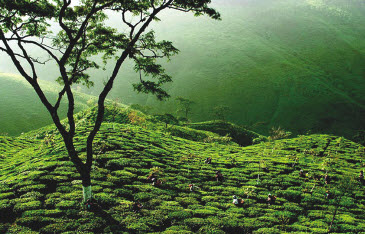NOVEMBER 2016
The harvest is just beginning in Argentina, the southernmost tea growing region in the world. Argentina is one of the top ten tea producing countries globally. Gardens there are tightly grouped in the far northeastern reaches of this South American land, covering 112,000 acres (45,000 hectares) in tea. The majority of the nation’s 8,000 producers are smallholders located in Misiones Province, a lush sub-tropical rainforest that is part of the Mata Atlantica biome. The region (sandwiched between Brazil and Paraguay) features a habitat with rich soil and abundant rain. Adjacent Corrientes Province accounts for 7 percent of production.
If Argentina were located in the Northern hemisphere, its tea growing region would share a climate identical to Taiwan.

This year November temperatures were unusually cool at the beginning of spring in the Southern Hemisphere. Argentina annually produces around 100,000 metric tons of tea, accounting for 90 percent of the tea grown in South America. Tea production from all nine countries in South America totals about 2 percent of the global harvest of 5 billion kilos. Northerly Peru, the country with the next biggest investment in tea, produces only 3,500 metric tons and neighboring Ecuador only 2,700 metric tons. Brazil grows 1,500 metric tons, according to a presentation by Patricia Parra, infusions chain coordination in Argentina’s Ministry of Agriculture, Livestock and Fisheries.
Argentina exports 75 percent of its tea, making it the 8th largest tea exporting country in 2015 with 4 percent of global volume. Tea exports have more than doubled in value in the past decade on steady volume averaging 75,000 metric tons. Most of Argentina’s tea (73 percent) is exported to the U.S. where it is packaged and blended as iced tea. In 1995 Argentina sent 25,000 metric tons to the U.S. a volume that has since risen to 55,000 metric ton. Chile is a long-established regional buyer that orders 9 percent and 3 percent is sent to Germany.
Argentine tea is rich in polyphenols, mild in flavor and bright in color. A popular local brand is Alvear, a combination of tea leaves, rose petals, citrus, and almonds. Argentine tea stays clear in cold infusions. Specialty growers are emerging but five of the 60 companies licensed to export tea account for 60 percent of export volume. About 3 percent of the tea is processed as green tea. About one quarter of exports are Rainforest Alliance Certified.
Gardens are a mix of seed plants and clonals (15 percent) selected for maximum yield and resistance to drought, disease and pests. Tea was first introduced in the 1920s with new plantings in the 1930s but logistics were always a concern. Buenos Aires is a 20-hour trip south with another two-weeks to New York, Baltimore, or New Orleans and other U.S. ports.
Processing was by hand and the industry remained small until 1950 where the government restricted tea imports which enhanced the prospects of local producers. A growth spurt followed as Argentina sought export partners, eventually displacing China as the top tea supplier to the U.S. Mechanical harvesting was introduced in 1965 and has steadily advanced to the high cost of labor. In 1999 the VSTP method of vertical axis rolling was developed. Currently 8 percent of tea is VSTP with 90 percent rotorvane CTC. Subsidies remain in place with a guaranteed minimum price set at the beginning of the harvest and a Tea Revolving Fund that recently provided 1,800 small and medium producers’ cooperatives direct assistance.
Domestic consumption is on a slight incline. In Buenos Aires a break for tea and snacks is called merienda, patterned after the 19th century Welsh who settled in Patagonia from where the tradition spread. “The Four Seasons Buenos Aires is a 13-story marble tower overlooking a French Renaissance mansion with a Belle Époque style facade housing 17 suites,” writes Biju Sukumaran for the Huffington Post. “With a luxurious wood and leather interior, the hotel’s Elena restaurant offers a selection of teas including their own signature “Pony Line” incorporating black tea, apple, cinnamon, clove, anise, and fennel. Teas are accompanied by toasted country bread with jams and butter and sweets like parfaits and soufflés can be ordered,” according to Sukumaran.
The domestic market consumes 6,000 metric tons of mainly black tea. Volume dipped during the global recession but consumption has remained steady due to retail prices that have been regulated since 2008 to maintain greater affordability to lower income groups. “Tea remains undynamic in comparison to soft drinks and coffee, according to Euromonitor International’s Tea in Argentina report. Cafés La Virginia (and its affiliated brands) led tea with a value share of 34 percent in 2015, writes Euromonitor.
“Tea volume is projected to grow by 2% per year over the forecast period – a large improvement on the marginal growth of the review period. This faster growth can be attributed to the fact that consumers are increasingly turning to healthy products, especially green tea and fruit/herbal tea,” according to the report.